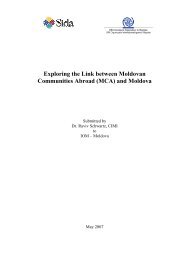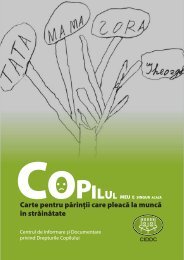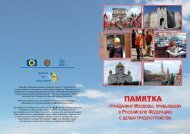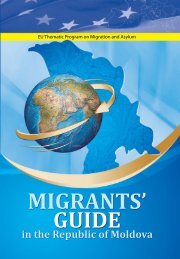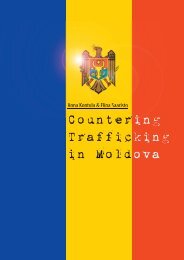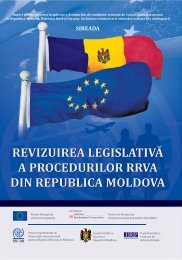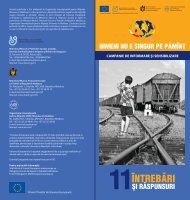Trafficking in Human Beings in Southeastern Europe - Iom
Trafficking in Human Beings in Southeastern Europe - Iom
Trafficking in Human Beings in Southeastern Europe - Iom
- No tags were found...
You also want an ePaper? Increase the reach of your titles
YUMPU automatically turns print PDFs into web optimized ePapers that Google loves.
<strong>Traffick<strong>in</strong>g</strong> <strong>in</strong> <strong>Human</strong> Be<strong>in</strong>gs<strong>in</strong> <strong>Southeastern</strong> <strong>Europe</strong>Introductionand OverviewAcross the SEE region, authorities are only beg<strong>in</strong>n<strong>in</strong>g to mobilise with regardsto HIV/AIDS. Experience <strong>in</strong> other regions of the world demonstrates theextremely high vulnerability of trafficked women and children to HIV/AIDSand STIs, which <strong>in</strong> turn places the users and their families and communitiesat risk of <strong>in</strong>fection. Typically, trafficked women work<strong>in</strong>g <strong>in</strong> the sex <strong>in</strong>dustry donot have access to health care and many report hav<strong>in</strong>g to cont<strong>in</strong>ue work<strong>in</strong>gdespite health problems, <strong>in</strong>clud<strong>in</strong>g STIs. The non-compliance of clients <strong>in</strong> theuse of condoms <strong>in</strong>creases the risk of <strong>in</strong>fection.In all the countries of the region, as part of the assistance offered by IOM totrafficked women who are return<strong>in</strong>g or returned back home, there is the possibilityof hav<strong>in</strong>g HIV/AIDS and STI tests on a voluntary basis (the tests areonly not available <strong>in</strong> Kosovo). Accord<strong>in</strong>g to IOM not all women are will<strong>in</strong>g tohave the HIV/AIDS test (the percentage of women do<strong>in</strong>g the tests variesdepend<strong>in</strong>g on the country from 20 to 80 percent). To date, there have onlybeen a few cases of women who went through the IOM programmes of return,had HIV/AIDS test and tested positive. In some countries, the shelter staff donot encourage women to have the test as they cannot guarantee confidentialityof the results. 16STI tests, which are often positive, are not usually followed up with the propertreatment. As the treatment lasts approximately two weeks and women whoawait repatriation with assistance of IOM usually only stay <strong>in</strong> the shelter for ashorter period of time, the treatment is not completed. After return to thecountries of orig<strong>in</strong>, only a small group of women have proper treatment whilethey are <strong>in</strong> contact with the support<strong>in</strong>g organisation. The only exception <strong>in</strong> theregion is Moldova, where the IOM programme offers the opportunity for aproper medical check up and treatment upon return.Numerous governmental and non-governmental agencies and UN Agencies,e.g. the Stability Pact for SEE, the Council of <strong>Europe</strong>, UNICEF, UNHCHR, OSCE,IOM etc. have begun to address the issues of traffick<strong>in</strong>g <strong>in</strong> women and children.This has helped to give these challenges a better profile and begun toplace them on regional and national agendas, e.g. Stability Pact Task Force on<strong>Traffick<strong>in</strong>g</strong> and National Plans of Action on traffick<strong>in</strong>g and HIV/AIDS. Awarenessof traffick<strong>in</strong>g and HIV/AIDS issues have, however, not taken root andmore work is needed to understand the <strong>in</strong>terrelated nature of the problem andtherefore the most appropriate response.10. <strong>Traffick<strong>in</strong>g</strong> of childrenThere is no reliable <strong>in</strong>formation or data on traffick<strong>in</strong>g of children. Although thescale of the traffic <strong>in</strong> children is unclear, <strong>in</strong>formation from across the regionsuggests that a grow<strong>in</strong>g number of children under 18, especially adolescentgirls, are be<strong>in</strong>g trafficked for the purposes of sexual exploitation and forcedlabour. In general, the traffick<strong>in</strong>g of children <strong>in</strong> SEE falls <strong>in</strong>to two categories:1) traffick<strong>in</strong>g of young children under 12 (girls and boys) for begg<strong>in</strong>g; and 2)traffick<strong>in</strong>g of teenage girls for sexual exploitation.A dist<strong>in</strong>ction needs to be made between the traffick<strong>in</strong>g of young children(under twelve) for begg<strong>in</strong>g, organs, adoption, prostitution, pornography andthe traffick<strong>in</strong>g of adolescent girls for prostitution. There is no evidence for theexistence of a special market for the sexual services of children or for virg<strong>in</strong>s<strong>in</strong> SEE, as is the case <strong>in</strong> other parts of the world <strong>in</strong> connection with the fear ofHIV/AIDS. There is evidence that young children, both girls and boys, are traf-1016.Interview with Lynellyn Long, IOM Office <strong>in</strong> BiH, 19 December 2001.



